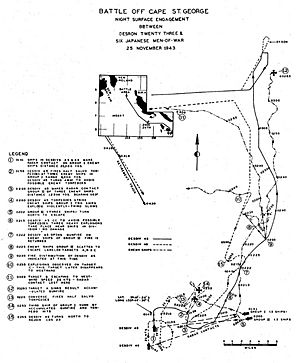Battle of Cape St. George facts for kids
Quick facts for kids Battle of Cape St. George |
|||||||
|---|---|---|---|---|---|---|---|
| Part of the Bougainville Campaign of the Pacific Theater (World War II) | |||||||
 Track chart of the battle |
|||||||
|
|||||||
| Belligerents | |||||||
| Commanders and leaders | |||||||
| Units involved | |||||||
| Destroyer Squadron 23 | Destroyer Division 31 | ||||||
| Strength | |||||||
| 5 destroyers | 5 destroyers | ||||||
| Casualties and losses | |||||||
| None | 3 destroyers sunk, 1 destroyer damaged, 647 killed |
||||||
The Battle of Cape St. George was a naval battle during World War II. It took place on November 25, 1943. The battle happened near Cape St. George and Buka Island in the Solomon Islands. It was the last time large warships fought each other in the Solomon Islands during the war.
In this battle, five US Navy destroyers, led by Captain Arleigh Burke, met five Japanese destroyers. The Japanese ships were leaving Buka after dropping off more troops. The US Navy won a big victory. Three Japanese destroyers were sunk, and one was damaged. The US forces had no losses.
Contents
Why Did the Battle Happen?
On November 1, 1943, American Marines landed on Bougainville Island. The Japanese thought this was a trick. They believed the real target was the airfields near Buka Island to the north. So, the Japanese decided to send more troops to Buka.
About 920 Japanese Army soldiers boarded three destroyers. These were the Amagiri, Yūgiri, and Uzuki. Two other destroyers, Ōnami and Makinami, went along to protect them.
US planes spotted this Japanese convoy. The United States Navy sent Destroyer Squadron 23 to stop them. This group had five destroyers: Charles Ausburne, Claxton, Dyson, Converse, and Spence. Captain Arleigh Burke led this US force. Nine PT boats also waited nearby to help if needed.
How the Battle Unfolded
The Japanese ships dropped off their troops and supplies. They also picked up 700 Navy airmen. These airmen were leaving Buka because Allied bombs had damaged the airfield. The Japanese force was heading back to Rabaul.
Just after midnight on November 25, 1943, US PT boats saw four Japanese ships on their radar. But the PT boats thought they were friendly ships and stopped. Two Japanese ships then attacked the PT boats. They fired their guns and tried to ram one PT boat, PT-318. They missed, but one PT boat, PT-64, fired a torpedo that also missed. The Japanese destroyers then sailed west.
Around 1:41 AM, Captain Burke's destroyers picked up the two lead Japanese destroyers on their radar. The US ships were positioned between Cape St. George and Buka. The Japanese ships could not see the Americans because of poor visibility.
Captain Burke decided to attack with torpedoes first. The American ships used their better radar to get very close, about 5,500 yards (5,000 meters). They launched their torpedoes around 1:55 AM before the Japanese saw them. The Japanese destroyer Onami was hit by several torpedoes and sank right away. All hands, including the Japanese commander, were lost. The destroyer Makinami was hit by one torpedo and was badly damaged.
Burke's force soon found the rest of the Japanese ships on radar. The three Japanese transport destroyers turned north and tried to escape. Two US destroyers, Converse and Spence, stayed behind to finish off the damaged Makinami. They sank her with more torpedoes and gunfire.
Burke's three destroyers chased the three Japanese ships. The Japanese ships were slower because they were heavily loaded. Around 2:22 AM, the US ships opened fire and hit the Japanese ships several times. The Uzuki was hit by a shell that did not explode, so it escaped without much damage. The Amagiri was not hit at all.
Around 2:25 AM, the Japanese ships split up and went in different directions. Burke chose to chase Yugiri with all his ships. After a fierce fight, they sank Yugiri around 3:28 AM.
What Happened After the Battle?
By 3:45 AM, all of Burke's and Austin's US destroyer divisions had joined up. They kept going north, chasing any remaining Japanese ships. But Burke called off the chase at 4:04 AM. His ships were low on fuel and ammunition. He needed to leave before daylight, when Japanese planes might start looking for them. When daylight came, the only planes the US ships saw were friendly American planes.
This battle was a big win for the Americans. It was later called an "almost perfect action." Captain Burke received a special medal, the Navy Cross, for his leadership. It was the last time surface ships fought in the Solomon Islands campaign. It was also the last such battle in the wider Pacific for nine months.
The Japanese were able to land their troops and pick up their airmen. But they lost three destroyers sunk and one damaged. The Americans had no losses. A total of 647 Japanese sailors were killed. Japanese submarines rescued 279 survivors from Yugiri and 11 others.
Ship Named After the Battle
The US Navy has a Ticonderoga-class guided-missile cruiser named USS Cape St. George (CG-71). This ship has been in service since 1993 and was named to honor this important battle.
Images for kids



